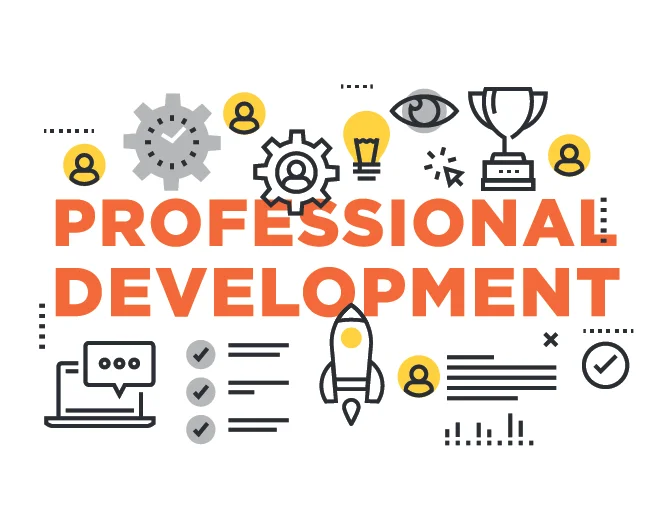Education is a constantly evolving field, and effective teaching requires continuous growth and adaptation. Professional development for educators ensures that teachers stay updated with new teaching strategies, emerging technologies, and evolving educational theories. By investing in continuing education, teachers enhance their skills, improve student outcomes, and stay motivated in their careers.
This guide explores:
- The benefits of professional development
- Key areas of continuing education for teachers
- Professional development opportunities
- Best practices for implementing ongoing learning
Why is Professional Development Essential for Educators?

1. Enhances Teaching Effectiveness
- New teaching methodologies and instructional strategies improve classroom engagement.
📌 Example: A teacher trained in differentiated instruction can tailor lessons to students with different abilities.
2. Keeps Educators Updated with Emerging Trends
- The education landscape is evolving with technology, neuroscience, and policy changes.
- Blended learning, AI in education, and competency-based learning are shaping modern classrooms.
📌 Example: Training in EdTech tools like Google Classroom or Kahoot enhances digital teaching skills.
3. Improves Student Outcomes
- Well-trained teachers boost student engagement, performance, and retention.
- Continuing education allows teachers to use research-backed techniques for better results.
📌 Example: A reading teacher trained in the Science of Reading (phonics-based instruction) can improve literacy rates.
4. Provides Career Advancement Opportunities
- Professional development can lead to certifications, leadership roles, and higher salaries.
- Teachers can specialize in STEM education, special education, or instructional coaching.
📌 Example: A teacher earning a National Board Certification can qualify for leadership positions.
5. Prevents Burnout & Increases Job Satisfaction
- Learning new skills and networking with peers reignites passion for teaching.
- Teachers who engage in professional development feel more competent and confident.
📌 Example: Mindfulness training helps teachers manage stress and create healthier learning environments.
Key Areas of Professional Development for Teachers
1. Pedagogical Strategies
- Differentiated instruction
- Culturally responsive teaching
- Project-based learning (PBL)
- Social-emotional learning (SEL)
📌 Example: A teacher trained in Universal Design for Learning (UDL) can create inclusive lesson plans.
2. Technology & Digital Learning
- Google Certified Educator training
- AI in education
- Flipped classroom techniques
- Virtual and augmented reality (VR/AR) in learning
📌 Example: Training in Gamification helps teachers make lessons more interactive.
3. Special Education & Inclusive Teaching
- Supporting students with ADHD, autism, and dyslexia
- Trauma-informed teaching
- Assistive technology in special education
📌 Example: A teacher completing an Orton-Gillingham certification can better support struggling readers.
4. Classroom Management & Student Engagement
- Restorative practices
- Positive behavior interventions and supports (PBIS)
- De-escalation strategies
📌 Example: A teacher trained in Restorative Justice techniques can handle student conflicts effectively.
5. Leadership & Career Growth
- Instructional coaching certification
- School administration training
- Teacher mentorship programs
📌 Example: Teachers with Education Leadership (Ed.D.) degrees can transition into principal or superintendent roles.
Top Professional Development Opportunities for Teachers
1. Workshops & Conferences
- ISTE (International Society for Technology in Education) – Focuses on digital learning.
- ASCD (Association for Supervision and Curriculum Development) – Covers curriculum trends and leadership.
- NCTM (National Council of Teachers of Mathematics) – Offers math teaching strategies.
📌 Tip: Attending national conferences allows teachers to network with experts and bring fresh ideas into their classrooms.
2. Online Courses & Certifications
- Coursera & edX – Free and paid courses on education topics.
- Google for Education Training – Google Certified Educator & Trainer credentials.
- Harvard’s Project Zero – Creative teaching and learning strategies.
📌 Tip: Micro-credentials allow teachers to gain specific skills without committing to full degrees.
3. Graduate Degrees & Advanced Certifications
- Master’s in Education (M.Ed.) – Specializations in curriculum design, leadership, or special education.
- National Board Certification (NBPTS) – A prestigious credential that improves teaching quality.
- TESOL Certification – Enhances skills for teaching English as a Second Language (ESL).
📌 Tip: Many schools offer tuition reimbursement for educators pursuing advanced degrees.
4. School-Based Professional Learning Communities (PLCs)
- Teacher-led workshops on best practices.
- Peer coaching and mentoring programs.
- Collaborative lesson planning sessions.
📌 Tip: PLC meetings foster a supportive environment where teachers can share challenges and solutions.
5. Action Research & Self-Directed Learning
- Conducting small-scale classroom research to test new methods.
- Reading education journals (e.g., Educational Leadership, The Reading Teacher).
- TED Talks and podcasts on teaching innovations.
📌 Tip: Keeping a teaching journal helps reflect on classroom successes and areas for growth.
Best Practices for Implementing Professional Development in Schools
1. Make PD Relevant & Practical
✔ Focus on real classroom challenges.
✔ Offer hands-on workshops instead of passive lectures.
📌 Tip: Teachers prefer PD that immediately improves their teaching practice knowledge.
2. Support Ongoing Learning (Not One-Time Events)
✔ Provide year-round training opportunities.
✔ Follow up PD sessions with coaching and mentoring.
📌 Tip: Studies show that sustained professional development leads to greater student success.
3. Encourage Teacher Leadership
✔ Let educators present PD sessions based on their expertise.
✔ Form teacher learning networks to share best practices.
📌 Tip: Teachers are more engaged when learning from their peers.
4. Use a Blended Learning Approach
✔ Combine in-person workshops, online modules, and self-paced learning.
✔ Use video recordings for flexible access.
📌 Tip: Hybrid models allow teachers to balance PD with their busy schedules.
5. Foster a Growth Mindset Culture
✔ Encourage teachers to take risks and experiment with new methods.
✔ Recognize and reward innovative teaching strategies.
📌 Tip: Schools that prioritize continuous learning create more motivated and engaged educators.
Conclusion: Investing in Educators for a Brighter Future
Professional development is not just an option—it’s a necessity for ensuring quality education and student success. By embracing lifelong learning, teachers can:
- Enhance their teaching strategies
- Stay current with educational advancements
- Improve student engagement and performance
- Advance in their careers
🎓 The best educators never stop learning!
What professional development experiences have helped you grow as a teacher? Share your insights in the comments! 📚✨



